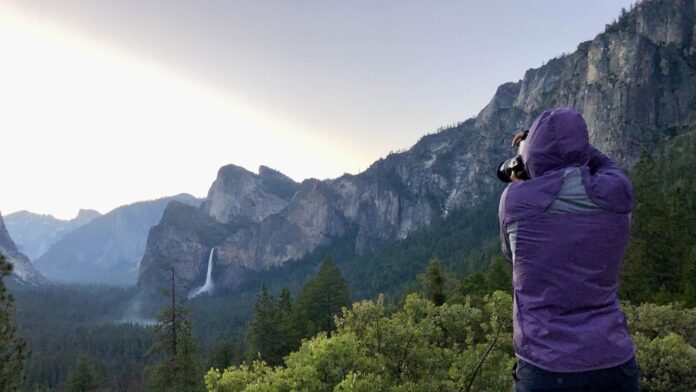The main event in Yosemite is of course all that glorious nature, but deciding where to stay is a big part of the planning too, especially since between three and five million people visit each year so there’s competition for a place to sleep. (A good thing to note though: According to the National Parks Service, 75% of visitors to Yosemite come between May and October.)
When I start planning a trip to Yosemite (most years I go at least once; some years two or three times), the first thing I decide is where to stay. I’ve stayed at many of the hotels, lodges, and campsites in the Yosemite Valley and outside the park, and I can confidently say that there’s no one right answer as to where you should stay on a visit.
Here’s the distillation of the information I carry around in my head to help me decide where to stay in Yosemite.
The pros and cons of staying in the Yosemite Valley
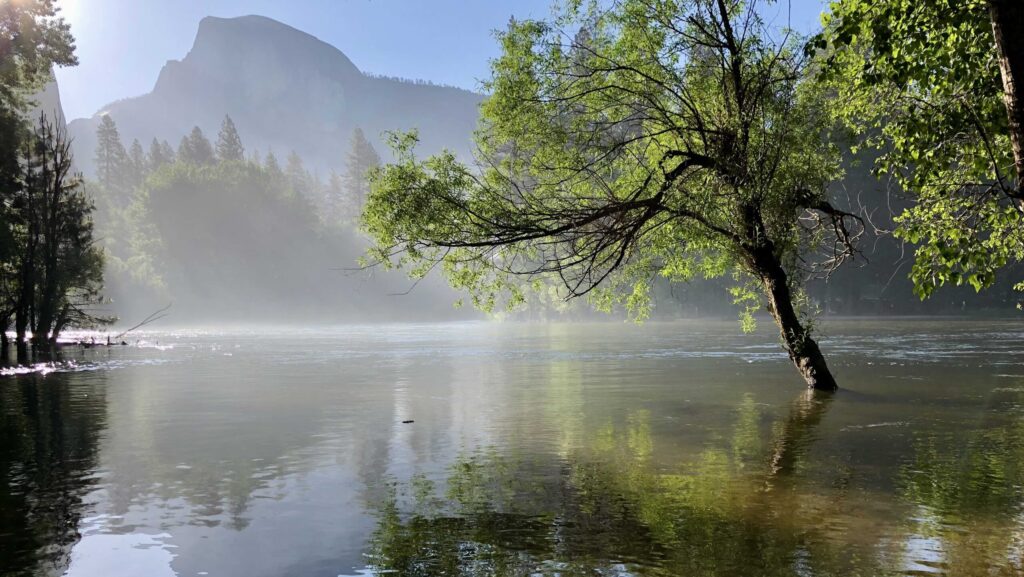
A stay in the Yosemite Valley means you’re close to much of what makes Yosemite absolutely amazing. You’ll be able to look out the window or walk outside your hotel (or campsite) and see jaw-droppingly beautiful sights like Half Dome and Yosemite Falls.
The major drawback is that since there’s a limited number of places to sleep in the valley, availability can often be an issue. During popular periods (like summer), you generally need to book pretty far in advance–though in my experience, if you’re going midweek during quieter seasons like winter, you can usually find decent availability, even pretty last minute.
Where to stay in Yosemite Valley
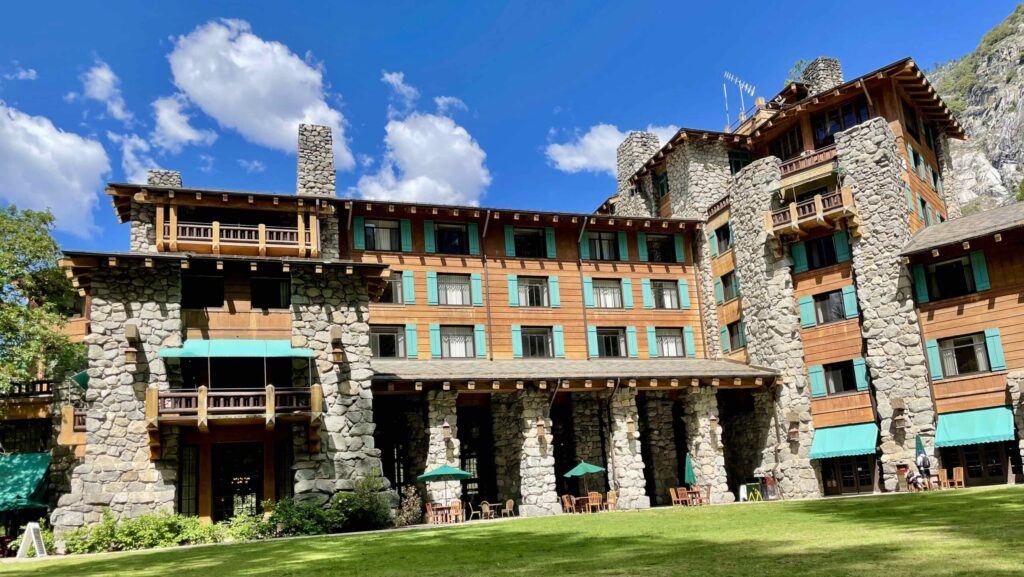
There are a few spots not in the valley but still in the park (Wawona, White Wolf Lodge, etc.) but most of those are seasonal, so for the sake of brevity, I’ll just cover the year-round options in the valley.
- The Ahwahnee: The Ahwahnee is a gorgeous example of the Parkitecture style and mixes Art Deco, Native American, and Arts & Crafts decor for its singular vibe. It’s a bit worn these days but is still worth a stay, both for its history and for its incredible location that frames views of Half Dome and Glacier Point. This is pretty much always going to be the most expensive option in the park, and if you’re willing to pay for it, you might consider checking pricing on suites, since they tend to be not that much more expensive than rooms.
- Yosemite Valley Lodge: Though it’s tucked into the trees, the Yosemite Valley Lodge really is right in the heart of the valley. From its restaurant you can look out the big windows and see Yosemite Falls, and all the delights of the valley are super walkable from this spot (it’s also on the shuttle bus stop). Rooms are functional and comfortable but not fancy–about what you’d expect from a mid-priced national park hotel.
- Curry Village: Curry Village is the size of a small town and has a mix of unheated and heated tent cabins, which have beds and electricity. There are also cabins that also include private bathrooms (in the tent cabins, you’ll rely on shared bathroom facilities).
- Housekeeping Camp: Housekeeping Camp is funky, with cement-floored canvas tents featuring barebones beds, plus shared bathrooms. But there’s something fun and festive about it; it feels like camping but you get to be 40% more comfortable than you’d be sleeping on the ground.
- Camping: Around the valley are 459 campsites for tent camping. The competition for these is fierce. Depending on which campsite you want, you’ll need to book five months, two weeks, or one week in advance.
The pros and cons of staying outside the national park
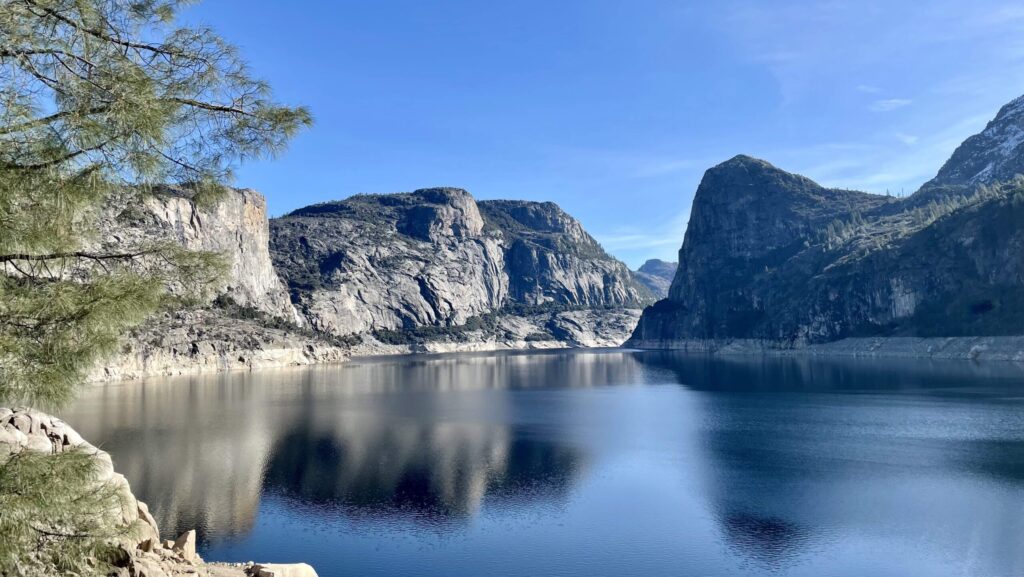
In my opinion, there are a few compelling reasons to stay outside the park. The first is purely logistical: There are more options and more rooms, and if you haven’t booked super far in advance, staying outside the park may be your only option. Another reason—and this one is more fun—is that there are some great spots to stay close to the park that offer perks like big beautiful heated pools, great spas, and stylish, modern, comfortable hotel rooms.
The downside of course is that you have to drive into and out of the park every time you want to visit, but that’s not always a bad thing, since it encourages you to explore beyond the valley. For instance, a stay at one of the hotels near the Big Oak Flat/Highway 120 entrance means you’re about 30 minutes away from the valley but are super close to some off-the-beaten path Yosemite gems like Merced Grove, which is home to some of the park’s giant sequoias; and Hetch Hetchy, a former valley that was controversially flooded in the 1920s and that now has some really amazing hiking trails that rival the best of the valley.
Yosemite has four entrances to the main part of the park (Hetch Hetchy has its own entrance). I’m including all four entrances here, even though the Tioga Pass entrance is seasonal and there aren’t many places to stay (I didn’t want it to feel left out even though I know entrances don’t have feelings).
Highway 120
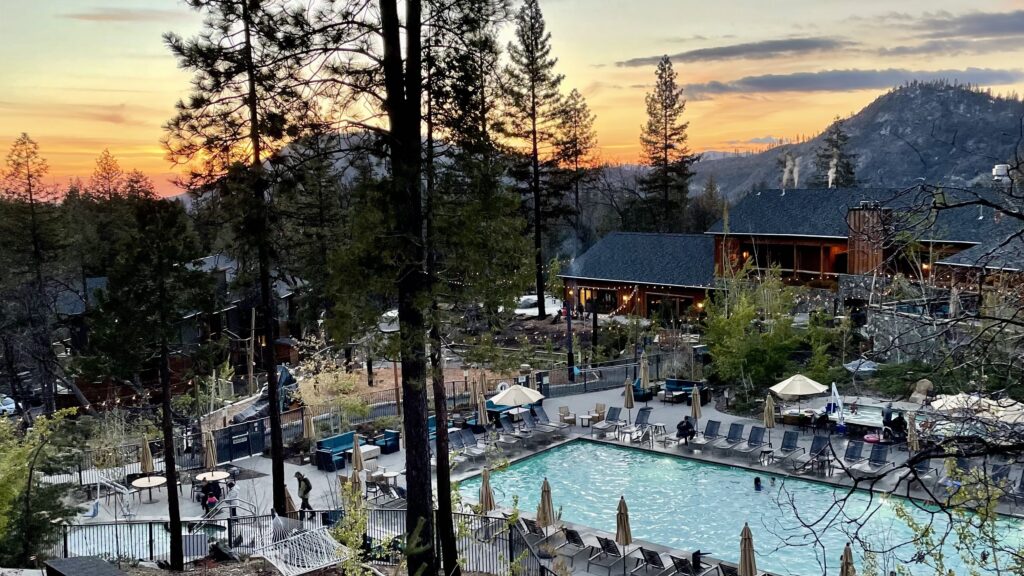
Highway 120 to the Big Oak Flat Entrance (and Hetch Hetchy): If you’re coming from the San Francisco Bay Area, you’ll likely come in either via this entrance or the Mariposa entrance a bit farther south. Groveland, about an hour from the valley, has some cute and quirky options like the Yosemite Pines RV Resort, which has a mix of cabins, yurts, campsites, and RV spots.
My favorite option though, is closer to the park entrance. Rush Creek Lodge sits above Highway 120 a little under a mile from the Big Oak Flat entrance to Yosemite. Rooms are modern and just a little luxurious, and around the property there are great perks like a big heated pool and an exceptional spa. Rush Creek’s big-sister property is the century-old Evergreen Lodge, about 15 minutes away down the road that leads to Hetch Hetchy (Hetch Hetchy Reservoir is part of Yosemite but has its own separate entrance). Evergreen is made up of cabins grouped together into “villages,” and feels like a comfortable summer camp. It also has a big pool and festive gathering areas.
Highway 140: Arch Rock Entrance
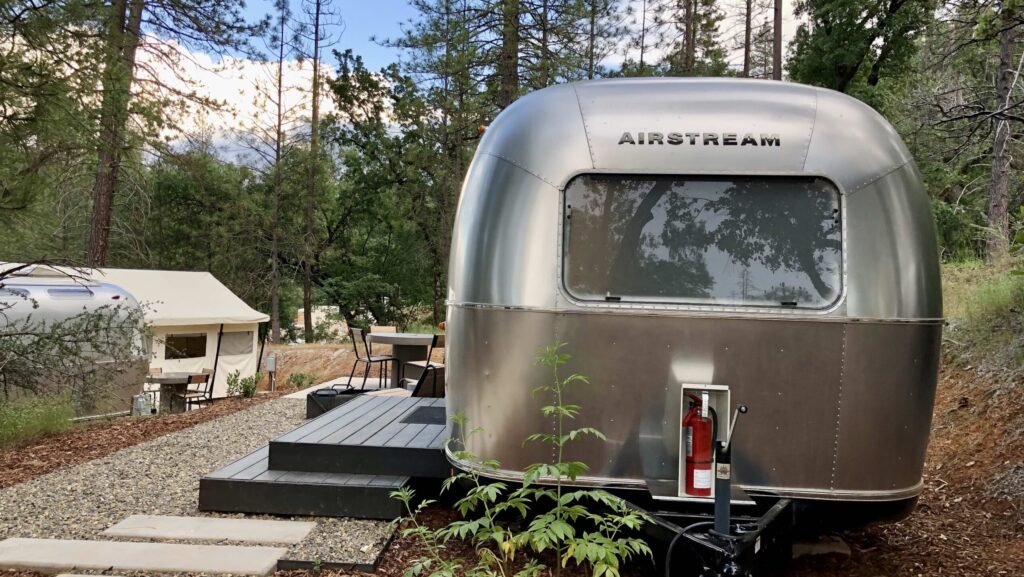
If you’re coming from the north or from the San Francisco Bay Area and you are someone (or are in the car with someone) who has a fear of heights, this is a better option than Highway 120 (Highway 120 has an amazing climb up a mountainside with a lot of switchbacks). Highway 140 takes you through cute towns like Mariposa and Midpines and along the Merced River, and it’s just generally a pretty drive. And once you’re at the Arch Rock Entrance, you’re less than 20 minutes from the Yosemite Valley.
There are a lot of places to stay near the park here: rustic and fun glamping spots like Autocamp Yosemite and Yosemite Bug Mountain Resort plus an abundance of B&Bs, inns, and vacation rentals. There’s also the large (300+ rooms) Yosemite View Lodge, which isn’t particularly fancy but does sit right on the river and is the closest option to the Arch Rock Entrance.
Highway 41: South Entrance
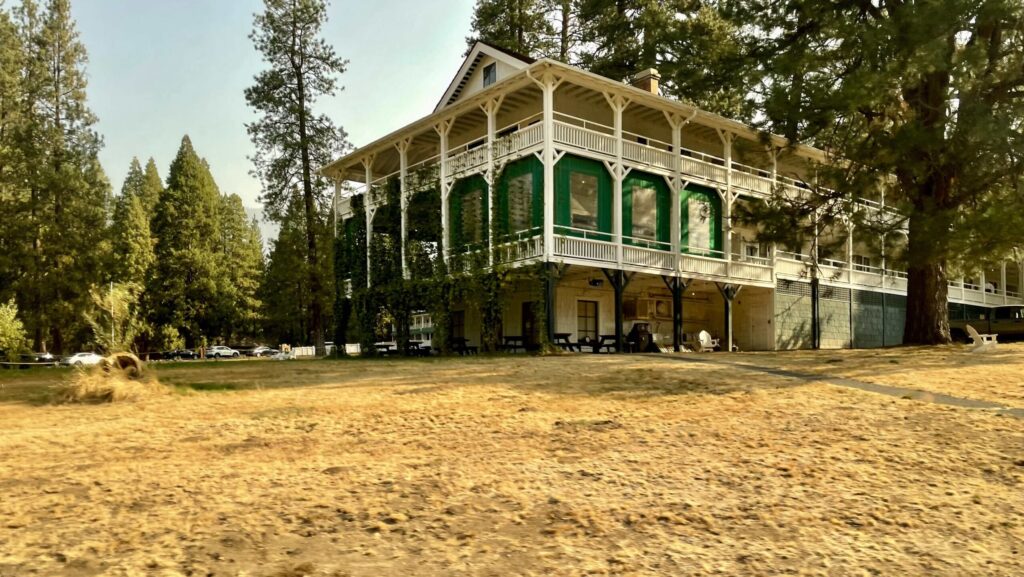
If you’re arriving from Southern or Central California, you’ll likely be driving in via the park’s South Entrance, close to the town of Fish Camp. From the South Entrance, it’s about 45 minutes down into the valley along a highway that was affected by wildfires (you’ll see a lot of charred trees).
The South Entrance is good if you want to include the park’s largest giant sequoia grove, Mariposa Grove. It’s also closer to Glacier Point and Wawona, and as you’re driving from this direction down into the valley, your first glimpse of the valley will be at Tunnel View (definitely definitely stop to enjoy the view and take some pics).
There’s a nice mix of hotels along the way, including Tenaya Lodge and Chateau du Sureau.
Highway 120 Tioga Pass Entrance
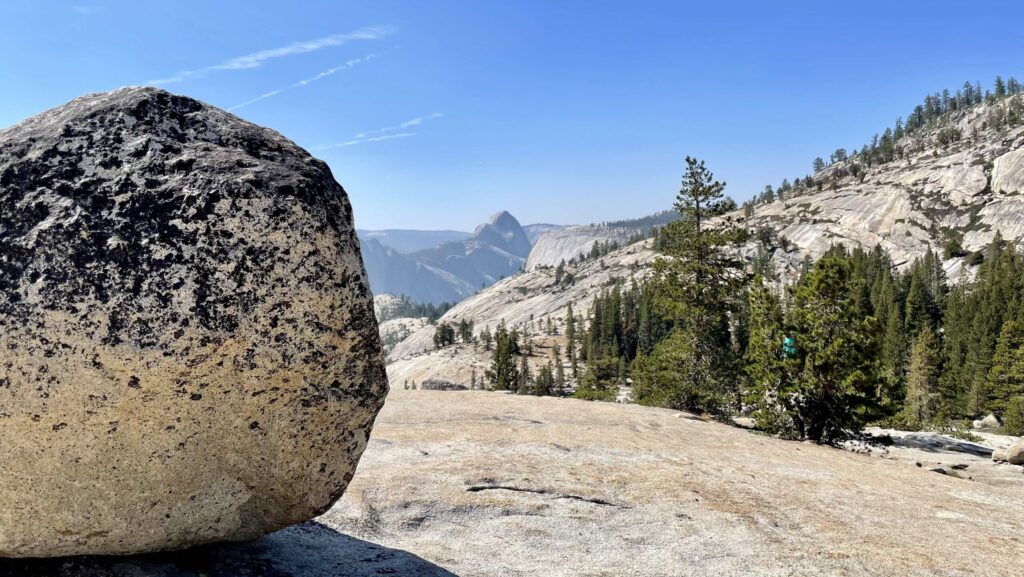
This seasonal entrance to the park is the easiest way in if you’re coming from Reno, Las Vegas, Death Valley, or other places east of Yosemite. From this entrance, it’s about an hour and a half into the valley, but it puts you close to Yosemite’s lesser-visited high country, which is beautiful and way less crowded than the valley.
However, the Tioga Pass entrance is only open a few months a year (generally May to October) and though it’s a lovely drive, there aren’t many places to stay until you get all the way back to Lee Vining. Because of all that, I don’t recommend staying beyond the Tioga Pass entrance if your goal is to be in the Yosemite Valley. But … if you’re heading into or out of the park on a road trip that includes Mono Lake, June Lake, or Mammoth in summer, this is a great way to go.


